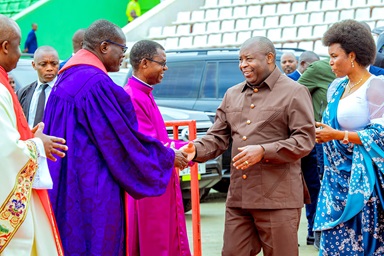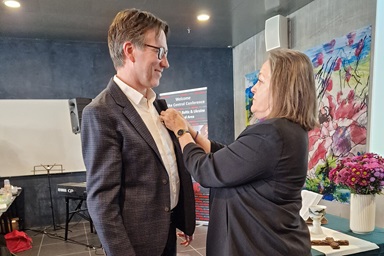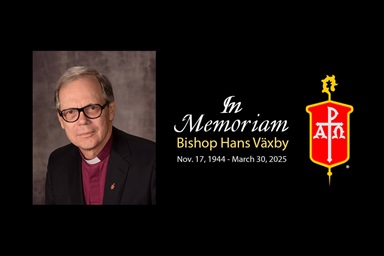Key points:
- Instead of a special session of General Conference, United Methodist bishops are calling for a leadership gathering in 2026.
- The bishops’ announcement has prompted questions from around the connection.
- Council of Bishops President Tracy S. Malone talked to United Methodist News about what is known so far about the event.
United Methodist bishops have called for a leadership gathering unlike the typical church meeting — one without parliamentary procedure or political wrangling.
Instead of deciding the denomination’s future, bishops expect the gathering’s participants to be dreaming and praying about what comes next for The United Methodist Church.
“It will have no decision-making authority because it’s a leadership gathering,” Council of Bishops President Tracy S. Malone said. “And the intent is to gather a group of leaders from across the denomination for the purpose of visioning and imagining the next expression of the church.”
The Council of Bishops announced Sept. 5 that it was planning a five-day leadership gathering in April or May 2026 — rather than calling for a special session of General Conference as announced last year. The bishops said their goal for the gathering is to “advance the positive momentum” of this year’s historic General Conference in Charlotte, North Carolina.
Malone, who also leads the Indiana Conference, told United Methodist News that she expects the leadership gathering to discuss varied topics. That includes how to be a more agile and efficient church, how to be an anti-racist church and, most importantly, how to fulfill the denomination’s mission to make disciples of Jesus Christ for the transformation of the world.
“The church is ready, and there’s such a hunger for something fresh, something new, something different to emerge,” Malone said. “And I’m hoping that we come out of this kind of gathering, creating this imaginative kind of space.”
The bishops’ plan immediately prompted concern from some United Methodists and excitement from others. But no matter their initial reactions, just about everyone has questions about what shape the event will take.
For one thing, the Book of Discipline — the denomination’s law book — has detailed rules for sessions of General Conference, United Methodists’ top lawmaking assembly. However, the Discipline has no such guidance for what the bishops have in mind, and the leadership gathering remains very much a work in progress.
Malone will name a design team to determine the gathering’s logistics, with specific dates and venue to be announced later. In the meantime, she spoke to United Methodist News about what is in the works so far for this new kind of gathering.
Why no special session?
The bishops initially announced their intention to call a special General Conference last November before any person knew what this year’s COVID-postponed assembly would decide or what the state of the denomination would be afterward.
Subscribe to our
e-newsletter
The special session in 2019, the last time General Conference met, had left the denomination with deeper division over LGBTQ inclusion and opened the door for U.S. churches to leave with property.
Most of the congregations that subsequently left — about a quarter of U.S. churches — supported the denomination’s longtime bans on “self-avowed practicing” gay clergy and same-sex marriage. But if the coming General Conference made no change, many bishops worried far more U.S. churches would leave.
Malone said the bishops announced the possibility of a special session in hopes of easing some anxieties. The hope was to tell the wider denomination that if this year’s General Conference ended in deadlock, the bishops were prepared to bring delegates together again “to figure out a way to hold this church together.”
But after this year’s General Conference, she said, “we came to the conclusion we didn’t need to have a special session, but we do need to convene and bring people together to build on that momentum.”
This year’s assembly, with nearly 700 delegates from four continents, proved to be especially productive. The final day’s morning worship exemplified the upbeat mood when delegates and bishops from all over the world joined hands in singing — and dancing to — the O’Jays’ “Love Train.”
Delegates, by sizable majorities, voted to end decades-old denomination-wide bans on gay clergy and same-sex marriage while also passing protections for clergy who choose not to officiate at same-sex weddings. Delegates also passed a whole new set of Social Principles, statements of social witness intended to better reflect the international nature of The United Methodist Church.
By 78% of the vote, delegates approved amending the constitution to allow for regionalization. Under regionalization, The United Methodist Church in the U.S. and the central conferences in Africa, Philippines and Europe would each become regional conferences with the same authority to adapt certain parts of the Book of Discipline for missional effectiveness — including on matters such as ordination standards and marriage rites.
But to be ratified, the constitutional amendment needs at least two-thirds of the total votes within annual conferences — church bodies consisting of clergy and lay delegates from multiple congregations and ministries. Bishops preside at both General Conference and annual conference sessions, but do not have a vote.
What does this mean for regionalization?
The bishops are planning the leadership gathering without knowing the outcome of the votes on regionalization.
Malone said the bishops hope to have constitutional amendment votes take place in all of the denomination’s 131 annual conferences by the end of next year. Bishops then plan to certify vote results when they meet in spring 2026, likely around the time of the leadership gathering. But even without having a complete vote tally, she expects the bishops and others at the gathering will have a sense of what the results will be.
“No matter what, we’re planning to have the leadership gathering in April or May,” she said.
But if regionalization passes, she said, she could see participants discussing what the next step should be to both allow for contextual ministry while not losing the core United Methodist value of connection.
“We’ll talk about how we still serve the whole church,” she said. “It’s all about generating ideas and imagination, and hopefully that would help us better prepare for 2028,” when the next General Conference is scheduled.
Who will attend the gathering?
The question of who will be part of these conversations is among the main concerns some United Methodists expressed about the leadership gathering.
The plan is for the participants to be active bishops, Council of Bishops officers, the top executives of the denomination’s 13 general agencies and three leaders from each of the denomination’s 53 episcopal areas chosen by the bishop in consultation with the lay and clergy leaders in that area.
The Council of Bishops also plans to invite about 50 additional United Methodists to include young people, theologians, innovators, missional leaders and retired bishops with particular experience or expertise. Altogether, this means the gathering will have fewer than 300 participants.
This is very different from General Conference, where annual conferences elect the delegates who vote. Half of those elected must be lay and half clergy, and altogether, they number more than twice the total of participants at the proposed leadership gathering.
Jessica Vittorio, a General Conference delegate from the North Texas Conference, was among those troubled by how participants are chosen.
“This proposed gathering removes structural protections regarding lay and clergy equalization, delegate elections (and therefore autonomy), and oversight of episcopal authority,” she said. “Now is the time for the church to move together to further the goals set by the General Conference. It is not the time to encourage segregation and politicking amongst various internal interest groups who will all be left vying for a seat at the table.”
Malone said she is sensitive to these concerns.
“We do want to make sure that we have lay and clergy at the event,” she said. “We want to make sure it’s intergenerational, and we want to make sure that it’s ethnically diverse — so a diversity of a number of perspectives. … As a council, we’re going to have some core values of making sure we have this diversity.”
What is still unknown?
Beyond exact dates and the venue, the bishops also are still trying to figure out various details.
That includes how to fund the gathering. In the denomination-wide budget passed at General Conference, delegates designated $7 million for a special session if the bishops chose to call one. But that money can only be used for a special session.
“Part of some of the strategic thinking of the design team and others will have to be: ‘What are those other sources of funding?’” Malone acknowledged.
She suggested that some of the expense might be covered by each episcopal area, with episcopal areas with more resources covering the expense for those with less.
Another detail still to be worked out is whether people who aren’t participants might observe the discussion. Malone stressed that she sees “transparency as the order of the day.” So her hope is that the design team finds ways to engage nonparticipants in the work being done.
“Part of gaining momentum is also garnering trust and engendering trust,” Malone said. “And how do you engender trust? With the spirit of transparency.”
What are the hopes for the event?
George Howard, a veteran General Conference delegate from the West Ohio Conference, is among the United Methodists excited about what a gathering like this might accomplish.
“What many of us have been yearning for are opportunities to dialogue, opportunities to think, opportunities to dream, opportunities to discern,” he said. “And legislation cuts that dreaming, discerning, dialogue process short. What they’re providing us with is a chance to pause, to take a deep breath and to think together.”
Malone sees the gathering as helping United Methodists express their faith in new, exciting ways that draw more people to Christ.
“I’m hoping that people come away from this feeling hopeful,” she said.
Hahn is assistant news editor for UM News. Contact her at (615) 742-5470 or [email protected]. To read more United Methodist news, subscribe to the free Daily or Friday Digests.




